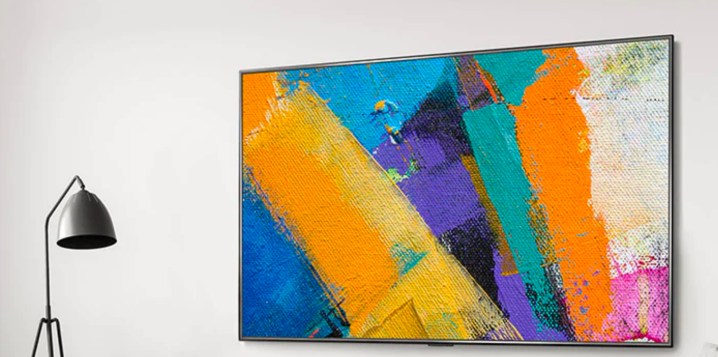
Some of the best TVs of 2020 come with a feature called Ambient Mode, Art Mode, or Gallery Mode. Different manufacturers market this feature under different names, but they’re by and large the same thing: The ability to transform a television from a giant black hole in your room to a gallery-quality piece of art that truly becomes part of your home’s space. Here’s everything you need to know.
- What is Ambient Mode in a TV?
- Which TVs have Ambient Mode, Art Mode, or Gallery Mode?
- What does Ambient Mode, Art Mode, or Gallery Mode really look like?
- A TV that truly blends into the room
- Customize your TV with personal art or your own photography
- What happens after repeated long-term use?
- What does Art Mode or Ambient Mode cost?
What is Ambient Mode in a TV?
In short, when you’re not watching the TV, Ambient Mode transforms your black screen into something meaningful. With Ambient Mode, the TV can mimic the wall pattern behind it to help blend in or show you 8K videos, gallery-quality art and photography, or even personal photos, as well as soothing moving patterns or helpful information like the weather.
Which TVs have Ambient Mode, Art Mode, or Gallery Mode?
More and more manufacturers are creating high-end 4K and 8K TVs with the ability to blend in. Samsung’s The Frame TV was one of the first, combining a completely flat TV screen with a proper art frame around the edges to transform the television from a piece of shiny, dark glass into a beautiful canvas without glare. Samsung continues to lead in this technology. Today, Ambient Mode is available mainly on its QLED TVs (models Q9FN, Q8CN, Q7FN, and Q6FN). QLED models with this function even have a special Ambient Mode button on the remote control to trigger the feature.
Newer LG TVs have similar technology that LG calls Gallery Mode. Touting the ultra-thin profile and a flush fit that makes the TV resemble a painting hanging on a wall, LG has been referring to its new OLED TVs as Gallery TVs. Read our LG Gallery Series GX 4K HDR OLED TV review.
What does Ambient Mode, Art Mode, or Gallery Mode really look like?
If you think back to the early days of TVs and screensavers, you know they weren’t much to look at. Simply a bright glaring wash of stock images, there wasn’t a lot that was artsy about TVs when they weren’t turned on.
With new modes like Ambient Mode, Art Mode, or Gallery Mode, TV screens take on a completely different characteristic. There’s no bright, harsh glare from the screen. In fact, the screen doesn’t really look like glass at all. It has a softness, a smoothness, and above all, a muted-ness to it that lets paintings and photography believably pose as legit art on your wall. The effect is stunningly subtle and realistic — and it doesn’t look anything like a cheap screensaver.
TVs with this feature also have other technology built-in to help the TV realistically adapt art mode to the room. Samsung’s Ambient Mode is self-adjusting. Brightness can be set to automatically match the level of light in the room so the art always looks realistic. You can also set a timer for these modes to turn off automatically, say after your company has left. Some can use motion-sensing technology to only turn Art Mode on when the TV senses someone is in the room.
A TV that truly blends into the room
If you’d really rather your TV disappear when it’s not being watched, another feature of these modes is that you can upload a photograph of the wall behind the TV so the TV “disappears” when not in use. Whether your TV is hung on brick, over wallpaper, or on a precisely-painted wall, you just take a photo and send it to the TV. Instant disappearing TV!
Customize your TV with personal art or your own photography
Naturally, in this customizable world, many TVs that support Ambient Mode, Art Mode, or Gallery Mode also give you the option of using your own art and photographs. Often, you can upload photos straight from your phone to the TV’s compatible app and have it playing on your TV in moments.
What happens after repeated long-term use?
With high-end TVs like these, you might wonder what happens to the display panel after years of art — especially if you like just a handful of paintings. Manufacturers are conscious of this question and offer a no-burn-in guarantee. How much energy does something like this use if the TV is supposed to be off? Samsung, for example, says its Frame TV uses only about 30% of the energy on Ambient Mode as the TV does when it’s fully in use in video mode.
What does Art Mode or Ambient Mode cost?
While most TVs that offer Ambient Mode, Art Mode, or Gallery Mode do supply a couple dozen images and options for free, you might have to pay for additional or specialty art or collections. This can cost a few dollars each month, though some manufacturers have unlimited plans, too. It depends on what you want and which TV you’re interested in.
Not only do these art and ambient modes look great, but they also turn your TV into part of the room instead of a decor distraction. Having this option for the home definitely means you have a lot more options for styling a TV into your room.
Editors' Recommendations
- QLED vs. OLED TVs: which is better and what’s the difference?
- The best 8K TVs for 2024: from Samsung, LG, and Sony
- LG is bringing Baby Shark and high-end art to its smart TVs with a range of new apps
- What is a Micro Lens Array, and how does it make OLED TVs brighter?
- What is transparency mode and how does it work?







